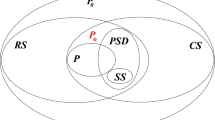Abstract
Superfluous matrices were introduced by Howe (1983) in linear complementarity. In general, producing examples of this class is tedious (a few examples can be found in Chapter 6 of Cottle, Pang and Stone (1992)). To overcome this problem, we define a new class of matrices\(\bar Z\) and establish that in\(\bar Z\) superfluous matrices of any ordern ⩾ 4 can easily be constructed. For every integerk, an example of a superfluous matrix of degreek is exhibited in the end.
Similar content being viewed by others
References
R.W. Cottle, J.S. Pang and R.E. Stone,The Linear Complementarity Problem (Academic Press, 1992).
M. Fiedler and V. Ptak, “On matrices with non-positive off diagonal elements and positive principal minors,”Czechoslovak Journal of Mathematics 12 (1962) 382–400.
G.B. Garcia, F.J. Gould and T.R. Turnbull, “Relations between PL maps, complementary cones and degree in linear complementarity problems,” in: B.C. Eaves et al., eds.,Homotopy Methods and Global Convergence (Plenum, New York, 1983) pp. 99–144.
M.S. Gowda, “Application of degree theory to the linear complementarity problem,”Mathematics of Operations Research 18 (1993) 868–879.
R. Howe, “On a class of linear complementarity problems of variable degree,” in: B.C. Eaves et al., eds.,Homotopy Methods and Global Convergence (Plenum, New York, 1983) pp. 155–178.
R. Howe and R.E. Stone, “Linear complementarity and the degree of mappings,” in: B.C. Eaves et al., eds.,Homotopy Methods and Global Convergence (Plenum, New York, 1983) pp. 179–224.
L.M. Kelly and L.T. Watson “Q-matrices and spherical geometry,”Linear Algebra and its Applications 25 (1979) 151–162.
S.R. Mohan, T. Parthasarathy and R. Sridhar, “The linear complementarity problem with exact order matrices,”Mathematics of Operations Research 19 (1994) 618–644.
S.R. Mohan and R. Sridhar, “On characterising N-matrices using linear complementarity,”Linear Algebra and its Applications 160 (1992) 231–245.
W.D. Morris, Jr., “On the maximum degree of an LCP map,”Mathematics of Operations Research 15 (1990) 423–429.
G.S.R. Murthy, T. Parthasarathy and G. Ravindran, “A copositive Q-matrix which is notR 0,”Mathematical Programming 61 (1993) 131–135.
K.G. Murty,Linear Complementarity, Linear and Nonlinear Programming (Heldermann-Verlag, West Berlin, 1988).
C. Olech, T. Parthasarathy and G. Ravindran, “A class of globally univalent differentiable mappings”,Archivum Mathematicum (Brno) 26 (1989) 165–172.
R. Sridhar, “Exact order matrices and Linear complementarity problem,” Ph.D. Thesis, Indian Statistical Institute, New Delhi, India, 1992.
R. Sridhar, “The degree of an exact order matrix,” I.S.I. Technical Report No. 9203, Indian Statistical Institute, New Delhi, India, 1992.
R.E. Stone, “Geometric aspects of the linear complementarity problem,” Ph.D. Thesis, Department of Operations Research, Stanford University, Stanford, CA, 1981.
Author information
Authors and Affiliations
Rights and permissions
About this article
Cite this article
Sridhar, R. Superfluous matrices in linear complementarity. Mathematical Programming 71, 195–206 (1995). https://doi.org/10.1007/BF01585998
Received:
Issue Date:
DOI: https://doi.org/10.1007/BF01585998




